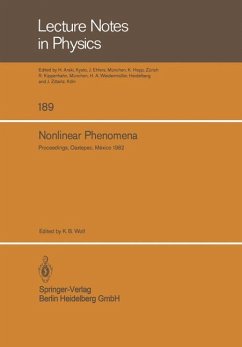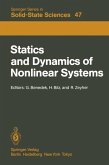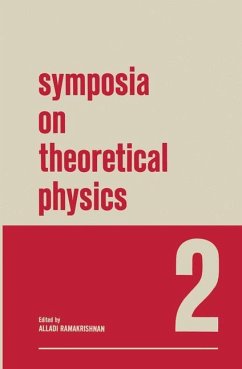Solitons
Herausgegeben von Bullough, R.K.; Caudrey, P.J.
Solitons
Herausgegeben von Bullough, R.K.; Caudrey, P.J.
- Broschiertes Buch
- Merkliste
- Auf die Merkliste
- Bewerten Bewerten
- Teilen
- Produkt teilen
- Produkterinnerung
- Produkterinnerung
Until the beginning of this decade the number of significant exactly soluble problems in physics was limited to a very few: the classical or quanti sed harmonic oscillator, the linearised many-body problem, the quanti sed hydrogen atom, Newton's solution of the planetary orbit problem, Onsager's solution of the two-dimensional Ising problem, almost exhaust the list. Now the situation is quite different. We have a large number of exactly soluble nonlinear systems of physical significance and the number of these is growing steadily. Recent examples include a limited solution of Ein stein's field…mehr
Andere Kunden interessierten sich auch für
![Nonlinear Phenomena Nonlinear Phenomena]() Nonlinear Phenomena39,99 €
Nonlinear Phenomena39,99 €![Statics and Dynamics of Nonlinear Systems Statics and Dynamics of Nonlinear Systems]() Statics and Dynamics of Nonlinear Systems77,99 €
Statics and Dynamics of Nonlinear Systems77,99 €![Inverse Methods in Action Inverse Methods in Action]() Inverse Methods in Action78,99 €
Inverse Methods in Action78,99 €![Integrable Hamiltonian Hierarchies Integrable Hamiltonian Hierarchies]() Vladimir GerdjikovIntegrable Hamiltonian Hierarchies75,99 €
Vladimir GerdjikovIntegrable Hamiltonian Hierarchies75,99 €![Advanced Synergetics Advanced Synergetics]() Hermann HakenAdvanced Synergetics39,99 €
Hermann HakenAdvanced Synergetics39,99 €![Integrable Hamiltonian Hierarchies Integrable Hamiltonian Hierarchies]() Vladimir GerdjikovIntegrable Hamiltonian Hierarchies76,99 €
Vladimir GerdjikovIntegrable Hamiltonian Hierarchies76,99 €![Symposia on Theoretical Physics Symposia on Theoretical Physics]() Alladi RamakrishnanSymposia on Theoretical Physics38,99 €
Alladi RamakrishnanSymposia on Theoretical Physics38,99 €-
-
-
Until the beginning of this decade the number of significant exactly soluble problems in physics was limited to a very few: the classical or quanti sed harmonic oscillator, the linearised many-body problem, the quanti sed hydrogen atom, Newton's solution of the planetary orbit problem, Onsager's solution of the two-dimensional Ising problem, almost exhaust the list. Now the situation is quite different. We have a large number of exactly soluble nonlinear systems of physical significance and the number of these is growing steadily. Recent examples include a limited solution of Ein stein's field equations!, an apparently exact solution of the quantised sine-Gordon 2 equation u - U = sin(u) which establishes connections with the Ising models , xx tt 3 and a solution of the equations of motion of a rigid body in g dimensions . This book is concerned with problems such as these. But more specifically it is concerned with solitons. These mathematical objects are exact, analytical, solutions of nonlinear wave or evolution equations like the sine-Gordon equation (s-G) or the Korteweg-de Vries equation (KdV) u + 6uu + u = O. The discovery by Gardner, t x xxx .
Hinweis: Dieser Artikel kann nur an eine deutsche Lieferadresse ausgeliefert werden.
Hinweis: Dieser Artikel kann nur an eine deutsche Lieferadresse ausgeliefert werden.
Produktdetails
- Produktdetails
- Topics in Current Physics .17
- Verlag: Springer / Springer Berlin Heidelberg / Springer, Berlin
- Artikelnr. des Verlages: 978-3-642-81450-1
- Softcover reprint of the original 1st ed. 1980
- Seitenzahl: 416
- Erscheinungstermin: 15. Dezember 2011
- Englisch
- Abmessung: 244mm x 170mm x 23mm
- Gewicht: 715g
- ISBN-13: 9783642814501
- ISBN-10: 3642814506
- Artikelnr.: 36113429
- Herstellerkennzeichnung Die Herstellerinformationen sind derzeit nicht verfügbar.
- Topics in Current Physics .17
- Verlag: Springer / Springer Berlin Heidelberg / Springer, Berlin
- Artikelnr. des Verlages: 978-3-642-81450-1
- Softcover reprint of the original 1st ed. 1980
- Seitenzahl: 416
- Erscheinungstermin: 15. Dezember 2011
- Englisch
- Abmessung: 244mm x 170mm x 23mm
- Gewicht: 715g
- ISBN-13: 9783642814501
- ISBN-10: 3642814506
- Artikelnr.: 36113429
- Herstellerkennzeichnung Die Herstellerinformationen sind derzeit nicht verfügbar.
1 The Soliton and Its History.- 1.1 Russell's Discovery of the 'Great Solitary Wave'.- 1.2 Definition of a Soliton: N-Soliton Solutions of Nonlinear Evolution Equations.- 1.3 Bäcklund Transformations and Conserved Densities.- 1.4 Other Physical Problems and the Discovery of the Inverse Method.- 1.5 Operator Pair Formulation of Nonlinear Evolution Equations.- 1.6 Discovery of Some Other N-Soliton Solutions: The AKNS-Zakharov-Shabat 2 × 2 Scattering Scheme and Its Geometry.- 1.7 Further Progress on Inverse Scattering Methods.- References.- 2. Aspects of Soliton Physics.- 2.1 Historical Remarks and Summary.- 2.2 Model Interacting Systems.- 2.3 Inverse Spectral Transformation and Motion Invariants.- Appendix A: Formal Derivation of the Marchenko Equations.- References.- 3. The Double Sine-Gordon Equations: A Physically Applicable System of Equations.- 3.1 Physical Background.- 3.2 Theory of Degenerate SIT.- 3.3 Spin Waves in Liquid 3He.- 3.4 Perturbation Theory for the Double Sine-Gordon Equation.- References.- 4. On a Nonlinear Lattice (The Toda Lattice).- 4.1 Nonlinear Lattices.- 4.2 The Exponential Interaction.- 4.3 Matrix Formalism.- 4.4 The Continuum Limit.- 4.5 Bäcklund Transformations.- 4.6 Concluding Remarks.- References.- 5. Direct Methods in Soliton Theory.- 5.1 Preliminaries.- 5.2 Properties of the D Operator.- 5.3 Solutions of the Bilinear Differential Equations.- 5.4 N-Soliton Solution of KdV-Type Equations.- 5.5 Bäcklund Transformations in Bilinear Form.- References.- 6. The Inverse Scattering Transform.- 6.1 General Discussion.- 6.2 The Generalized Zakharov-Shabat Eigenvalue Problem.- 6.3 Evolution of the Scattering Data.- 6.4 The Squared Eigenfunctions and Fourier Expansions.- 6.5 Evolution Equations of Class I.- 6.6 Hamiltonian Structure of theEquations of Class I.- 6.7 Systems with Two Dispersion Relations.- 6.8 Coherent Pulse Propagation.- 6.9 Moving Eigenvalues.- 6.10 The Sine-Gordon Equation.- 6.11 Schrödinger Equation.- 6.12 A Singular Perturbation Theory.- 6.13 Conclusion.- References.- 7. The Inverse Scattering Method.- 7.1 Preliminary Remarks.- 7.2 The Method of Finding "L-A" Pairs.- 7.3 Elementary Multidimensional Generalisation.- 7.4 Dressing " $$ hat L - hat A $$" Pairs.- 7.5 The Problem of Reduction and the Physical Interpretation of Examples.- 7.6 Two Dimensional Instability of Solitons.- 7.7 Exact Solutions of Equations in Nonlinear Optics.- 7.8 " $$ hat L,hat A,hat B $$" Triad.- 7.9 The Conservation of the Spectrum of Operator Families.- 7.10 The "Dressing" of Operator Families.- References.- 8. Generalized Matrix Form of the Inverse Scattering Method.- 8.1 Historical Remarks.- 8.2 The Inverse Scattering Problem.- 8.3 The Inverse Scattering Method and Solvable Equations.- 8.4 Extension to Lattice Problems.- 8.5 Concluding Remarks.- References.- 9. Nonlinear Evolution Equations Solvable by the Inverse Spectral Transform Associated with the Matrix Schrödinger Equation.- 9.1 Direct and Inverse Matrix Schrödinger Problem; Notation.- 9.2 Generalized Wronskian Relations; Basic Formulae.- 9.3 Nonlinear Evolution Equations Solvable by the Inverse Spectral Transform; Solitons.- 9.4 The Boomeron Equation and Other Solvable Nonlinear Evolution Equations Related to it; Boomerons.- 9.5 Bäcklund Transformations.- 9.6 Nonlinear Superposition Principle.- 9.7 Conserved Quantities.- 9.8 Generalized Resolvent Formula.- 9.9 Nonlinear Operator Identities.- References.- 10. A Method of Solving the Periodic Problem for the KdV Equation and Its Generalizations.- 10.1 One-Dimensional SystemsAdmitting a Lax Representation; Their Stationary Solutions.- 10.2 Finite-Zoned Linear Operators.- 10.3 Hamiltonian Formalism for KdV in Stationary and Nonstationary Problems.- 10.4 The Akhiezer Function and Its Applications.- References.- 11. A Hamiltonian Interpretation of the Inverse Scattering Method.- 11.1 The Hamiltonian Formulation.- 11.2 Complete Integrability of the Nonlinear Schrödinger Equation.- 11.3 Applications to the Quantization Problem.- References.- 12. Quantum Solitons in Statistical Physics.- 12.1 Preliminary Remarks.- 12.2 Quantization and Quantum Solitons.- 12.3 Continuum Field Equations.- 12.4 Eigenvalue Spectrum.- References.- Further Remarks on John Scott Russel and on the Early History of His Solitary Wave.- Note Added in Proof (Chapter 1).- Additional References with Titles.
1 The Soliton and Its History.- 1.1 Russell's Discovery of the 'Great Solitary Wave'.- 1.2 Definition of a Soliton: N-Soliton Solutions of Nonlinear Evolution Equations.- 1.3 Bäcklund Transformations and Conserved Densities.- 1.4 Other Physical Problems and the Discovery of the Inverse Method.- 1.5 Operator Pair Formulation of Nonlinear Evolution Equations.- 1.6 Discovery of Some Other N-Soliton Solutions: The AKNS-Zakharov-Shabat 2 × 2 Scattering Scheme and Its Geometry.- 1.7 Further Progress on Inverse Scattering Methods.- References.- 2. Aspects of Soliton Physics.- 2.1 Historical Remarks and Summary.- 2.2 Model Interacting Systems.- 2.3 Inverse Spectral Transformation and Motion Invariants.- Appendix A: Formal Derivation of the Marchenko Equations.- References.- 3. The Double Sine-Gordon Equations: A Physically Applicable System of Equations.- 3.1 Physical Background.- 3.2 Theory of Degenerate SIT.- 3.3 Spin Waves in Liquid 3He.- 3.4 Perturbation Theory for the Double Sine-Gordon Equation.- References.- 4. On a Nonlinear Lattice (The Toda Lattice).- 4.1 Nonlinear Lattices.- 4.2 The Exponential Interaction.- 4.3 Matrix Formalism.- 4.4 The Continuum Limit.- 4.5 Bäcklund Transformations.- 4.6 Concluding Remarks.- References.- 5. Direct Methods in Soliton Theory.- 5.1 Preliminaries.- 5.2 Properties of the D Operator.- 5.3 Solutions of the Bilinear Differential Equations.- 5.4 N-Soliton Solution of KdV-Type Equations.- 5.5 Bäcklund Transformations in Bilinear Form.- References.- 6. The Inverse Scattering Transform.- 6.1 General Discussion.- 6.2 The Generalized Zakharov-Shabat Eigenvalue Problem.- 6.3 Evolution of the Scattering Data.- 6.4 The Squared Eigenfunctions and Fourier Expansions.- 6.5 Evolution Equations of Class I.- 6.6 Hamiltonian Structure of theEquations of Class I.- 6.7 Systems with Two Dispersion Relations.- 6.8 Coherent Pulse Propagation.- 6.9 Moving Eigenvalues.- 6.10 The Sine-Gordon Equation.- 6.11 Schrödinger Equation.- 6.12 A Singular Perturbation Theory.- 6.13 Conclusion.- References.- 7. The Inverse Scattering Method.- 7.1 Preliminary Remarks.- 7.2 The Method of Finding "L-A" Pairs.- 7.3 Elementary Multidimensional Generalisation.- 7.4 Dressing " $$ hat L - hat A $$" Pairs.- 7.5 The Problem of Reduction and the Physical Interpretation of Examples.- 7.6 Two Dimensional Instability of Solitons.- 7.7 Exact Solutions of Equations in Nonlinear Optics.- 7.8 " $$ hat L,hat A,hat B $$" Triad.- 7.9 The Conservation of the Spectrum of Operator Families.- 7.10 The "Dressing" of Operator Families.- References.- 8. Generalized Matrix Form of the Inverse Scattering Method.- 8.1 Historical Remarks.- 8.2 The Inverse Scattering Problem.- 8.3 The Inverse Scattering Method and Solvable Equations.- 8.4 Extension to Lattice Problems.- 8.5 Concluding Remarks.- References.- 9. Nonlinear Evolution Equations Solvable by the Inverse Spectral Transform Associated with the Matrix Schrödinger Equation.- 9.1 Direct and Inverse Matrix Schrödinger Problem; Notation.- 9.2 Generalized Wronskian Relations; Basic Formulae.- 9.3 Nonlinear Evolution Equations Solvable by the Inverse Spectral Transform; Solitons.- 9.4 The Boomeron Equation and Other Solvable Nonlinear Evolution Equations Related to it; Boomerons.- 9.5 Bäcklund Transformations.- 9.6 Nonlinear Superposition Principle.- 9.7 Conserved Quantities.- 9.8 Generalized Resolvent Formula.- 9.9 Nonlinear Operator Identities.- References.- 10. A Method of Solving the Periodic Problem for the KdV Equation and Its Generalizations.- 10.1 One-Dimensional SystemsAdmitting a Lax Representation; Their Stationary Solutions.- 10.2 Finite-Zoned Linear Operators.- 10.3 Hamiltonian Formalism for KdV in Stationary and Nonstationary Problems.- 10.4 The Akhiezer Function and Its Applications.- References.- 11. A Hamiltonian Interpretation of the Inverse Scattering Method.- 11.1 The Hamiltonian Formulation.- 11.2 Complete Integrability of the Nonlinear Schrödinger Equation.- 11.3 Applications to the Quantization Problem.- References.- 12. Quantum Solitons in Statistical Physics.- 12.1 Preliminary Remarks.- 12.2 Quantization and Quantum Solitons.- 12.3 Continuum Field Equations.- 12.4 Eigenvalue Spectrum.- References.- Further Remarks on John Scott Russel and on the Early History of His Solitary Wave.- Note Added in Proof (Chapter 1).- Additional References with Titles.








